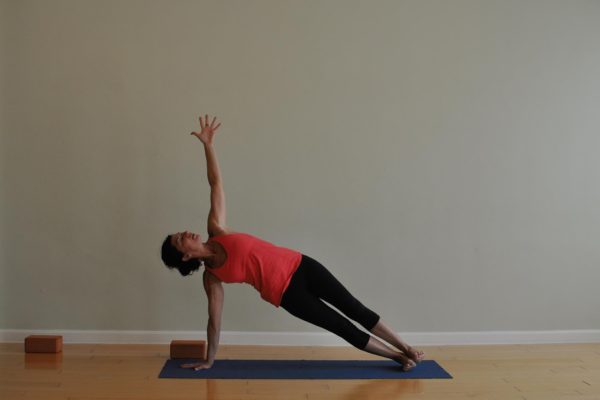
Once you’ve been teaching for a while, it can be fun to create anatomically based themes for your classes. The reason I suggest doing this after you’ve been teaching for some time is that it’s important to have a solid base of teaching in place with a standard sequence before you start changing things up. While it might seem easy to create and use an anatomical theme in class, it’ll give you more to think about and that can be trying for a new teacher. So, get that standard sequence under your belt and be confident in teaching it. Once you’ve built that solid foundation, it’s easier to then try a sequence focused on a particular anatomical theme.
One of the themes I like to use is one I call “Strengthen, Lengthen, Mobilize and Meditate.” These 4 terms capture much of what we’re doing in yoga and provide a balanced approach to practice. They are also general anatomical themes versus something specific, such as “external and internal rotation of the hip” so they can be an introductory way for teachers to bring anatomy into their teaching.
When I say above these 4 terms provide a “balanced approach to practice” what I mean is that if we focus on just strengthening or just lengthening, we won’t be giving people a chance to build balance in their bodies. If we consider that each person coming to the mat sits somewhere along a strength/length continuum, we can then think that in order for them to find more balance in their bodies, they may need more of one of those aspects of physicality. Think about a weight lifter who is very strong but comes to yoga to try to build more flexibility. Now, think of a dancer who’s very flexible but hypermobile and wants to build more strength. Both of these individuals need to gain more of one of those aspects of anatomy and yoga focused on both of those things will help them maintain and gain at the same time.
Let’s take a look at some poses that focus on these two aspects of practice:
Strength: Plank and variations like Side Plank, Forearm Plank and Dolphin Plank, Low Push Up
Length: Downward Dog, Triangle, Upward Dog, Straddle Forward Fold and associated variations
Now, some poses are hybrids, focusing on length and strength at the same time.
These include:
Warrior 1 and 2, Side Angle and its variations, Crescent Lunge
Now, let’s look at poses that focus on the idea of mobilizing, which refers to moving the joints:
- Any pose that includes interlacing the fingers behind the back (or using a strap) to mobilize the shoulder joints
- Squats/ Goddess Pose to mobilize the hips
- Eagle Pose to mobilize the shoulders
- Side to side lunges
- Hand to Big Toe pose (standing or on back) to mobilize the hip
- Happy Baby with movement to mobilize the hips
- Twists on the back to mobilize the hip
Now, let’s take a look at themes of meditation you can bring into teaching:
- Focused gaze/Drishti
- Adding a 5 minute seated meditation to the class
- Teaching ujjayi breath
- Facilitating a body scan prior to full Shavasana
Now, you’ll see that much of what I suggest above is not complicated. The poses are fundamental poses but what we’re doing here is looking at them through a slightly different lens. It also requires that in order to bring the correct emphasis to each set of postures, you’ll need to understand what specific muscles are strengthening and lengthening so you can cue them appropriately and help your students get a sense of what muscles to contract and what muscles are lengthened as a result of the posture.
The other piece to remember is that in the poses that focus on lengthening, we don’t want students to push to their further range in the pose. So, for instance, in Hand to Big Toe pose, especially if on the back, encourage students to stop before their “furthest point” that they could go, to ensure that they do not overdo the stretch. This applies even to a basic pose like Downward Dog (in regards to the hamstrings).
You could start out your class with a discussion of the theme you’ll present so that as you teach, you can call on the different aspects of the overall theme and it will make sense to your students.
For more on how to build sequences, download my template below:
Thanks for reading and please comment below with your thoughts. Does this makes sense? What anatomical themes do you like to use?
